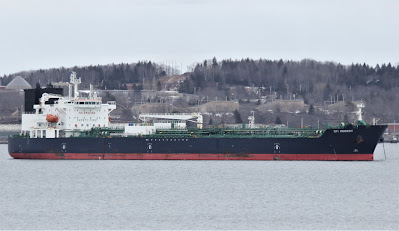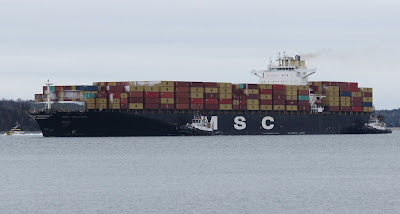My post a few days ago showing the impressive bows of the Royal Viking cruise ships is another reminder that ship design has changed over the years. Modern computer programs allow for ship's hulls to be maximized for such factors as cargo capacity (including passengers) or speed through the water. Graceful appearance is not always the end result. Even cruise ships, supposedly the most stylish of vessels, are quite rightly criticized as resembling "blocks of flats".
I recall as a youth reading in Sea Breezes the letters from crusty old salts barking about the degradation of standards in ship design. Such horrors as engines aft were cited as the first steps to perdition. I have long since entered the age range of those old gaffers and can see their point. Ship's appearances have changed, and not necessarily for the better aesthetically.

Elder Dempster's Lithgows- Port Glasgow built Fulani of 1964 was considered by many to be typical of the epitome of ship design (although the bi-pod masts were criticized as a modern affectation by the oldsters), but at 7689 gt and 8115 dwt its cargo capacity was limited by today's standards. Its hull dimensions were a sleek 141.7m x 19.0m. and it had a decent turn of speed of 16 knots. In its defence, it was designed for west African trade, which was slow, and often had to handle cargo to or from lighters or surf boats at anchorages, with ittle support from shore. It was equipped with an astonishing 16 derricks: 1x80, 2x30, 4x15, 2x12 1/2, 4x71/2, and 6x5 tons.
(The epitome may not yet have been reached in car design as an inspection of the longshoremen's vehicles may reveal.)
The incoming at 11 o'clock high appears to be an RCN "Tracker" aircraft heading for Shearwater. TheASW planes flew off the aircraft carrier HMCS Bonaventure which was still in commission in 1969. Ships like the Fulani were overtaken by the container revolution and were soon broken up or consigned to remote trades. It was sold twice, renamed 1976: Cam Azobe, 1981: Cotton Trader. After an explosion and fire in the Gulf of Oman July 13, 1983 it was broken up on Gadani Beach in May 1985.
By comparison, a ship of similar size (but vastly different appearance) arrived in Halifax on January 11.
Augusta Unity's hull dimensions of 143.2m x 22.8m give 12,993 gt and 17,451 dwt - the latter nearly twice that of the Fulani. The more box shaped hull is compensated for in part by a bulbous bow. It also requires only two cranes as most of its mixed cargo consists of containers which can also be handled from shore.
The Augusta Unity carried the name Federal Pioneer from 2007 to 2011, inviting the inevitable comparison to the wartime standard ship of the same name.
United Shipyards of Montreal delivered the Outremont Park to the Canadian government's wartime shipping company Park Steamships in 1944. One of hundreds of similar ships built in Canada and the US during World War II, it was considered large for its time at 7158 gt, 10,000 (approximate) dwt with hull dimensions of 134.6m x 17.4m. It became Furness' Prince Line's Brazilian Prince in 1946 and Federal Commerce and Navigation's Federal Pioneer in 1958. Used for northern supply for many years (with the hope that its bottom would fall out in the arctic somewhere) it managed to survive until 1971 when it was broken up in Hsinkiang, China after having sailed on its own hull from Halifax.
But back to Bows...
One overriding aspect of ship's designs applies to those built to break ice. On January 12 I could see two icebreaker bows from the same place. The heavy reinforcing was quite visible on the CCGS Jean Goodwill. It was tied up at Pier 9 due to a space shortage at BIO.
Nearby at Halifax Shipyard, AOPV3, the future HMCS Mac Burnays, was bows on.
Thicker plating at the bow is clearly visible even at a distance.
What happens when you don't have a reinforced bow has been seen in Halifax from time to time.
In June 1974 the bulker Ivory Star struck a growler in the Strait of Belle Isle and suffered a giant hole in the bow. The CCGS Montcalm removed 33 of the 43 persons aboard and the ship made for Halifax. Workers from Halifax Shipyards reinforced the collision bulkhead and the ship sailed cautiously to Europe for permanent repairs - still with the gaping hole. (Note the enclosed crow's nest from where someone might have spotted the growler in time to avoid it.)
Quite remarkably the ship was back in Halifax in October of the same year - good as new. Note the lack of bulbous bow - they were still uncommon in the 1960s.
For the record the ship was built in 1963 as the Norwegian Jarosa by Frederikstad MV. In 1972 Greek owners purchased and renamed the ship Ivory Star. Its gross tonnage was adjusted from 16,321 to 14,336 with deadweight of 24,790 tonnes. It was sold and re named Turicum in 1975 and Iapetos in 1979.
On December 8, 1983 it was abandoned by the crew after it came under rocket and machine gun air attack off Bandar Khomeni while en route from Immingham. It was apparently at least partially repaired, but on March 29, 1984 it was again attacked by air, this time with bombs and missiles, in the Khor Mussa channel while en route to Piraeus.
The ship was towed to Dubai and later sold for scrap. It was then towed to Chittagong where it was broken up in January 1985.
The Ivory Star could have used some ice reinforcing such as that of the Danish Lauritzen ships which pioneered winter navigation on the St.Lawrence in the early 1960s. Helga Dan, built in 1957, reached Quebec City February 13, 1959 and Montreal January 4, 1964, setting new records and establishing Montreal as a year round port (for some kinds of ships).
Despite the jolity of the linehandlers, many thought that winter navigation on the St.Lawrence would be the death knell for the Port of Halifax.
The 4040 gt, 5050 dwt ship, built by H.C.Stulcken Sohn in Hamburg also carried an array of cargo handling gear, consisting of 1x35, 4x10, and 6x5 ton derricks.
Renmaed Mitsa K. in 1974, it was wrecked April 4, 1982 and broken up in nearby Laurium, Greece. The high crowsnest must have been a challenge to reach in bad weather. (The ladder is just visible on the opposite side of the foremast.)
Containers saved the day for Halifax as the harbour was able to accommodate larger ships than Montreal could, and most container ships were not reinforced for ice, but that is for a later post.
More bow wows another time.........






















































